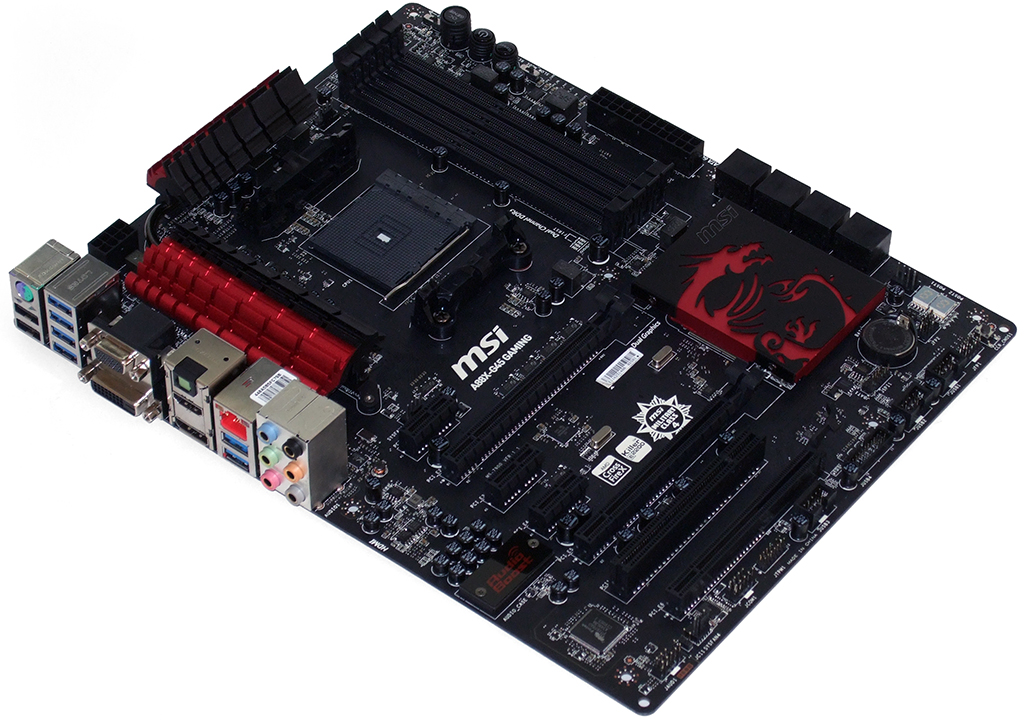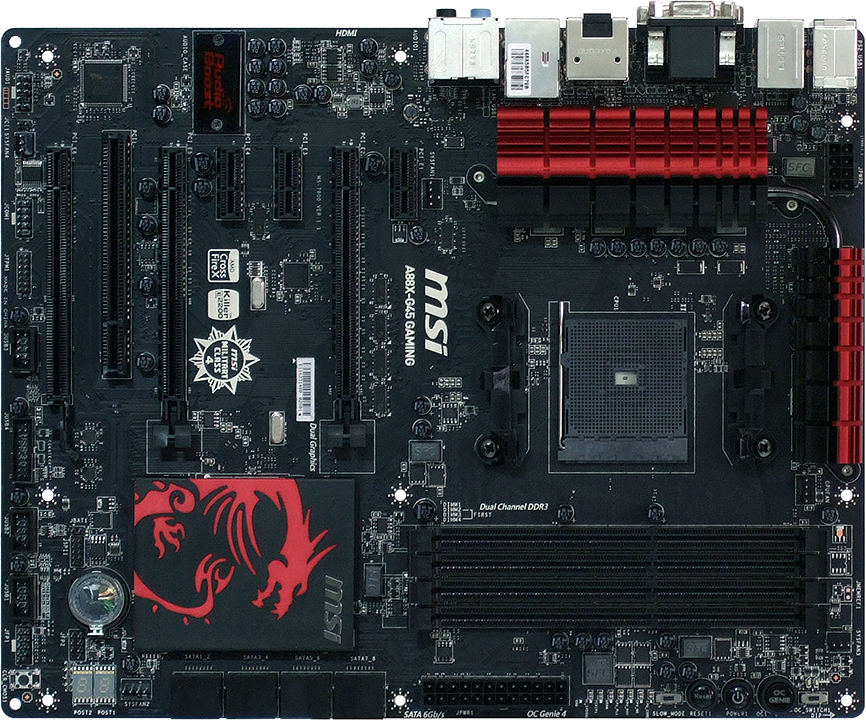Which A88X-Based Board Should You Buy For Your Kaveri APU?
MSI A88X-G45 Gaming
An Assassin’s Creed Liberation HD registration key (worth $20 on Steam) and a Killer E2200 GbE controller add relevance to the Gaming Limited Edition label of MSI’s A88X-G45. The motherboard also exercises AMD’s triple graphics card option by splitting sixteen PCIe 3.0-capable lanes across two of its three x16-length slots (when a second card is added), and even bolsters rear-panel USB 3.0 to six ports through a third-party controller.
Add an OC switch for two levels of automatic overclocking via the OC Genie button, a Slow Mode switch to underclock (which can help with booting if you're using LN2), and you’ll begin to wonder what’s missing from the A88X-G45 Gaming. Power, reset, and CLR_CMOS buttons are still there, just in case you’re trying to run this motherboard outside of a case. A Port 80 diagnostics display is present for diagnosing an overclocking-incurred lock-up. And though the board has no eSATA connectivity, all eight of the chipset's ports are exposed internally. Even the eight-channel audio codec is the modern, ALC1150 version.
The $120 A88X-G45 Gaming does cost a little more than its rivals, but enthusiasts who want the free game will note that the included code more than offsets the price difference. MSI’s six-phase voltage regulator is the only specification that comes up a little short of Asus and Gigabyte, but we could have a tough time stressing even six phases with AMD’s mainstream Kaveri-based APU family.
Judging specifications alone, the A88X-G45 Gaming appears to be a top value. But only testing reveals whether the board can keep up with its competition.
And then there’s the matter of layout: MSI claims perfect slot spacing on its A88X-G45 Gaming webpage, but the image that shows three cards at triple-slot spacing is fictitious. A look at the board proves that the second and third x16 slots are double-slot spaced. In and of itself, that shouldn't be a problem for most cards, aside from the location of MSI's USB 3.0 header. Located beneath the bottom x16-length slot, the front-panel USB 3.0 header can’t be used in conjunction with any dual-slot card. Even some single-slot GPU coolers will get in the way, since the cables that plug here tend to be extra-stiff. Gigabyte has the same issue with its second USB 3.0 front-panel header. But at least the F2A88X-UP4 has a primary header in an easy-access location.
MSI beats Gigabyte's platform with PCIe x1 support. On the A88X-G45 Gaming, lane sharing occurs between x1 slots two and three, rather than sharing between the third x1 and third x16 slot. In other words, it is possible to use three dual-slot graphics cards at x8-x8-x4 mode, plus two PCIe x1 cards, simultaneously.
If we pretend that front-panel USB 3.0 doesn’t matter, the A88X-G45 Gaming appears a top competitor. But if we acknowledge that front-panel USB 3.0 is important to many builders, we need to treat the board as if it only supports two double-slot cards.
Get Tom's Hardware's best news and in-depth reviews, straight to your inbox.
The A88X-G45 Gaming Limited Edition motherboard includes four SATA cables, documentation, and a certificate for the game titled on its box.
-
gadgety To me the point of Kaveri is great graphics in a small package, thus the MB would have to be as small as possible. M-ITX is currently the smallest. Someone should bring out a NUC sized board for the Kaveri.Reply -
blackmagnum On the other side of the fence... Haswell+ Maxwell= performance/watt/buck. You're welcome.Reply -
ta152h The IO device is called PS/2, not P/S 2. It stands for Personal System/2, the IBM product line from 1987. Also, there's a chance there's a big performance gain from Catalyst 14.2, instead of 14.1. Another site did benchmarks comparing 13.6 and 14.2, and the difference was dramatic. It most likely was the somewhere in the 13.6 to 14.1 range, though. I thought the days of one motherboard having significantly faster memory timings than the other died with the IMCs. After being shocked at the horrible performance of the Kaveri, and the almost complete failure of it, between the driver update, and advantage the Asus has, it's clear AMD pulled another "Hawaii", and put their technology in the worst possible light by not packaging it with the proper associated support technologies. Considering the long development cycles for these devices, it's hard to understand how AMD couldn't figure out a proper cooler for the Hawaii, or have drivers degrade performance so much for Kaveri, that within a month or so they were able to increase performance so dramatically. And now, it's clear the memory performance optimizations were far from complete. And Kaveri was a delayed product. It boggles the mind that they consistently fail to find such obvious shortcomings, when everyone else finds them pretty quickly. Clearly, their testing procedures need serious revision in scope.Reply -
ferooxidan "To me the point of Kaveri is great graphics in a small package, thus the MB would have to be as small as possible. M-ITX is currently the smallest. Someone should bring out a NUC sized board for the Kaveri."No, the best NUC will be Haswell + Maxwell, period.Reply -
almarcy Thank you for a useful grid of the current products. I am migrating from my current dinosaur. I am not at all interested in smaller, sleeker, tighter. Just faster. ~4 GHz with 2.4 GHz DDR3 for under $500. seems pretty irresistible :)Reply -
Someone Somewhere Can we see some benchmarks on the Killer card vs other competitors? It feels like FUD to me.Reply -
beerdette "No, the best NUC will be Haswell + Maxwell, period."The point of Kaveri on a NUC would be not to have the space that a graphics card takes. So it wouldn't be the best NUC because then you need to add space for that card.Reply -
de5_Roy Reply
yes. but at a lower price range probably. first, a10 7850k itself has to come down in price by $40-50 outside microcenter.12925440 said:Is anyone actually going to buy an ATX Kaveri motherboard?
-
vertexx Reply12925643 said:
yes. but at a lower price range probably. first, a10 7850k itself has to come down in price by $40-50 outside microcenter.12925440 said:Is anyone actually going to buy an ATX Kaveri motherboard?
Even beyond price, ATX seems pointless with a Kaveri APU. Myself, I'm waiting for the A8-7600 to build a very small (< 3 liters) ITX HTPC running the APU in 45W mode. Although I'm very excited about doing that build, I can't see any use case that makes sense for a Kaveri APU in an ATX form factor. Perhaps the A88x chipset has some feature benefit for building something using the 750 or 760k CPU in a budget build. But the only build I would even think about using a Kaveri APU in would be a mini-ITX PC/HTPC or laptop.
Beyond that, I would love to see Lian-Li come out with a tiny case like the PC-Q02, PC-Q09 or PC-Q12, but with the design for a single 120mm CLC and a 300W SFX PSU to allow a decent overclock on a 7850k APU with the smallest form factor possible (i.e. < 8 liters). That type of build might get me jazzed up for the 7850k.



